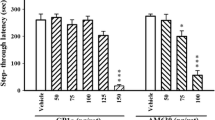Abstract
Treatments that increased intracellular cyclic 3′, 5′ adenosine monophosphate (cAMP) levels following catecholamine depletion caused by α-methyl-p-tyrosine (AMPT) provided a prophylactic effect against AMPT-induced amnesia. This effect gives evidence that cAMP mediated the formation of memory. In Experiment I, the phosphodiesterase inhibitor papaverine (50 mg/kg), immediately after a one-trial acquisition task, functionally increased cAMP levels and prevented amnesia 3 h after treatment with AMPT (200 mg/kg) for New Zealand A strain (NZ/A) mice tested in a step-through passive avoidance apparatus. Retention test latencies 72 h later were significantly higher for animals that received only saline and for animals that received AMPT and papaverine than for animals that received AMPT and saline (the amnesic group). In a similar task (Experiment II), mice that received an intracerebroventricular injection of either 5 or 10 μg dibutyryl cAMP immediately after acquisition and 3 h after AMPT administration showed significantly higher retention test latencies than animals that received AMPT and saline. The AMP plus 10 μg dibutyryl cAMP group showed facilitated performance even compared to the saline plus saline group.
Similar content being viewed by others
References
Bloom FE (1975) Central noradrenergic synaptic mechanisms. In: Tower PB (ed) Basic neurosciences, vol 1. Raven, New York, pp 373–380
Chute DL, Wright DC (1973) Retrograde state-dependent learning. Science 180:878–880
Chute DL, Villiger JW, Dragunow MG (1980) Evaluating cyclic AMP mediation of memory. Soc Neurosci Abstr 6:111
Daly JW (1975) The role of cyclic nucleotides in the nervous system. In: Iversen LL, Iversen SD, Snyder SH (eds) Handbook of psychopharmacology, vol 5. Plenum, New York, pp 47–107
Dismukes RK, Rake AV (1972) Involvement of biogenic amines in memory formation. Psychopharmacologia 20:42–47
Flood JF, Jarvik ME (1976) Drug influence on learning and memory. In: Rosensweig MR, Bennett EL (eds) Neural mechanisms in learning and memory. MIT, Massachusetts, pp 483–507
Gispen WH, Perumal R, Wilson JL, Glassman E (1977) Phosphorylation of proteins of synaptosome-enriched fraction of brain during short-term training experience: The effects of various behavioural treatments. Behav Biol 21:358–363
Gleeson RM, Dragunow MG, Kirton NF, Villiger JW, Chute DL (1980) Intracranial cannulation of small animals. Behav Res Methods Instrum 12:346–348
Greengard P (1976) Possible role for cyclic nucleotides and phosphorylated membrane proteins in post-synaptic actions of neurotransmitters. Science 260:101–107
Greengard P, Kuo JF (1970) On the mechanism of action of cyclic AMP. Ad Biochem Psychopharmacol 3:287–306
Haycock JW, van Buskirk R, McGaugh JL (1977) Effects of catecholaminergic drugs upon memory storage processes in mice. Behav Biol 20:281–310
Iversen LL (1979) The chemistry of the brain. Sci Am 241:118–129
Kety SS (1970) The biogenic amines in the central nervous system: Their possible role in arousal, emotion, and learning. In: Quarton GC, Melnechuk J, Adelman G (eds) The neurosciences second study programme. Rockefeller University Press, New York, pp 324–335
Kurtz P, Palfai T (1977) Mechanisms in retrograde amnesia: A case for biogenic amines. Biobehav Rev 1:23–33
Palfai T, Brown OM, Walsh TJ (1978) Catecholamine levels in the whole brain and the probability of memory formation are not related. Pharmacol Biochem Behav 8:717–721
Villiger JW, Chute DL (1979a) The possible role of cyclic AMP in the mediation of biogenic amines and hormone effects on memory. In: Proceeding of the Australia-New Zealand Association for the Advancement of Science. University of Auckland Press, Auckland 2:770
Villiger JW, Chute DL (1979b) Papaverine facilitates passive avoidance in mice. Soc Neurosci Abstr 5:326
Widerlow E, Lewander T (1978) Inhibition of in vivo biosynthesis and changes of catecholamine levels in rat brain after α-methyl-p-tyrosine in rats. Naunyn-Schmiedebergs Arch Pharmacol 304:111–124
Williams M, Rodknight R (1977) Protein phosphorylation in nervous tissue: Possible involvement in nervous tissue function and relationship to cyclic nucleotide metabolism. Prog Neurobiol 8:183–250
Author information
Authors and Affiliations
Rights and permissions
About this article
Cite this article
Chute, D.L., Villiger, J.W. & Kirton, N.F. Testing cyclic AMP mediation of memory: Reversal of α-methyl-p-tyrosine-induced amnesia. Psychopharmacology 74, 129–131 (1981). https://doi.org/10.1007/BF00432678
Received:
Accepted:
Issue Date:
DOI: https://doi.org/10.1007/BF00432678




